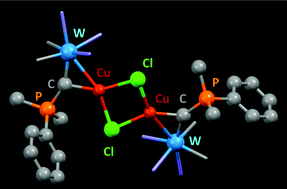Metal coordination of phosphoniocarbynes†
Abstract
Heterobi- and tetrametallic phosphoniocarbyne bridged complexes [WAu(μ-CPMe2Ph)Cl(CO)2(Tp*)]+ (Tp* = hydrotris(3,5-dimethylpyrazol-1-yl)borate), [W2Cu2(μ-CPMe2Ph)2(μ-Cl)2(CO)4(Tp*)2]2+ and [WPt(μ-CPMe2Ph)(COD)(CO)2(Tp*)]+ (COD = 1,5-cyclo-octadiene) arise from the reactions of the mononuclear terminal phosphoniocarbyne [W(![[triple bond, length as m-dash]](https://www.rsc.org/images/entities/char_e002.gif) CPMe2Ph)(CO)2(Tp*)]PF6 with [AuCl(THT)] (THT = tetrahydrothiophene), [CuCl(SMe2)] and [Pt(nbe)3] (nbe = norbornene) in the presence of COD. The COD ligand in [WPt(μ-CPMe2Ph)(COD)(CO)2(Tp*)]+ is labile and readily replaced by isonitriles to provide [WPt(μ-CPMe2Ph)(CNR)2(CO)2(Tp*)]+ (R = tBu, C6H2Me3-2,4,6) with retention of the tungstaplatinacyclopropene core, the bonding within which was computationally interrogated.
CPMe2Ph)(CO)2(Tp*)]PF6 with [AuCl(THT)] (THT = tetrahydrothiophene), [CuCl(SMe2)] and [Pt(nbe)3] (nbe = norbornene) in the presence of COD. The COD ligand in [WPt(μ-CPMe2Ph)(COD)(CO)2(Tp*)]+ is labile and readily replaced by isonitriles to provide [WPt(μ-CPMe2Ph)(CNR)2(CO)2(Tp*)]+ (R = tBu, C6H2Me3-2,4,6) with retention of the tungstaplatinacyclopropene core, the bonding within which was computationally interrogated.



 Please wait while we load your content...
Please wait while we load your content...